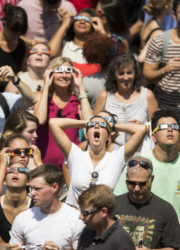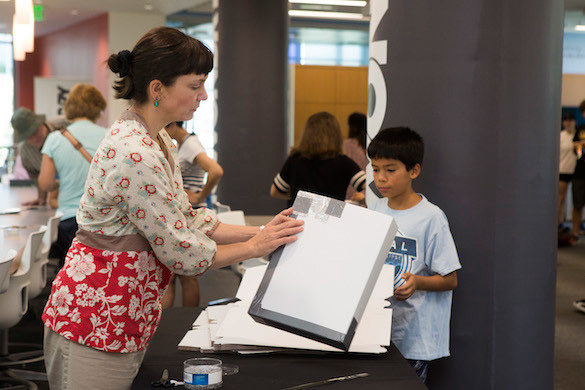On Monday, Aug. 21, 2017, Vanderbilt University students, faculty and staff gathered to view the first total eclipse visible in the Nashville area in 538 years, and the first coast-to-coast total eclipse on U.S. soil in 99 years. Though clouds in the east obscured the eclipse in downtown Nashville, where many of the city’s official events took place, the Vanderbilt campus had a clear view.
Wearing special safety glasses, the Vanderbilt community gazed skyward to watch the moon gradually cover the face of the sun. A few minutes before the sun became completely obscured, the sky rapidly began to darken, the hot afternoon became noticeably cooler and at 1:27 p.m., Baily’s beads flashed briefly along the last remaining sliver of sun as the eclipse became total. Though stars were hard to see against the glow of city lights, the planet Venus was easy to spot in the west, and the crickets and cicadas, confused by the sudden twilight, began to chirp. People gasped and cheered as they removed their safety glasses in order to better view the eerie glow of the sun’s pale corona streaming out from behind the black disk of the moon. One minute and 55 seconds later, Baily’s beads flashed on the other side of the sun, totality ended, and the moon continued on its journey around the Earth. Viewers replaced their safety glasses but remained fixed on the sun for a little while longer before returning their attention to more terrestrial matters.

“What a joy it was to experience this historic solar eclipse,” said Chancellor Nicholas S. Zeppos, who attended the university’s main viewing party on Alumni Lawn. “During a time in our nation and in our world that is all too often marked by division and disagreement, we are so fortunate that Vanderbilt’s diverse, global community of students, faculty and staff shared this phenomenal moment together, united in the same sense of awe and amazement.”
The university celebrated with campus viewing parties and prepared for the big day with months of educational and creative programming, including an educational open house the morning of the eclipse. It was also an important day for research: The School of Engineering participated in a nationwide NASA weather-balloon project to monitor the eclipse from the stratosphere, while a Vanderbilt astronomer and student traveled to a farm on the Kentucky border away from city lights to collect data on a mysterious phenomenon only visible during total eclipses and celebrate the event with numerous Vanderbilt alumni. The Vanderbilt University Amateur Radio Club at the School of Engineering communicated with amateur radio operators across the southeastern United States via a radio repeater aboard the School of Engineering’s balloon.
‘Dores in the Dark – Alumni Lawn
Around 10,000 Vanderbilt students, faculty and staff celebrated the eclipse on Alumni Lawn with ice cream, photo stations and eclipse-themed cornhole games. The official program began with welcome remarks from Provost Wente, whose office sponsored both the Alumni Lawn viewing party as well as a special one for Vanderbilt’s first-year students at The Commons. A large video screen shared Vanderbilt-produced videos about the science of eclipses, as well as video feeds from NASA and the Vanderbilt weather balloon. Music inspired by the sun, moon and outer space played on the loudspeakers between videos, and veteran Vanderbilt sportscaster Joe Fisher and Vanderbilt University Department of Public Safety program coordinator and former broadcast meteorologist Jeff Burrowes emceed the program.
Just a few minutes before totality, Pink Floyd’s “Eclipse,” from their 1973 album Dark Side of the Moon, began to play on the loudspeakers, timed perfectly to end the moment the sun became completely obscured by the moon. Some attendees attempted to photograph the eclipsed sun, though most simply stood and took in the sight.
As daylight began to reappear, Richard Strauss’ 1896 tone poem Also Sprach Zarathustra, whose opening fanfare is fittingly titled “Sunrise” and which was used as the theme song for Stanley Kubrick’s 1968 film about interstellar exploration, 2001: A Space Odyssey, played on the loudspeakers. The party continued for another half-hour, and by the time it ended the day was as bright and hot as it had been before.
“Our students and faculty spent the past year exploring this remarkable event scientifically, culturally and creatively, but nothing can prepare you for the eclipse itself,” said Wente. “A total solar eclipse is one of the most awe-inspiring sights in nature, and I’m so happy I was able to share it with my Vanderbilt family.”
‘Dores in the Dark – The Ingram Commons
The Class of 2021’s freshman photo featured a little something extra – the approximately 1,600 students not only stood to form the number 2021, but looked skyward in eclipse glasses for one of the shots.
The portrait marked the final event in a series of fun and educational programming surrounding the eclipse. First, freshmen gathered on The Martha Rivers Ingram Commons lawn to listen to an astronomy-related playlist and learn about the rare occurrence they were watching. As totality approached, the group exploded in shouts, whistles and applause – doing the same as the light returned. As the skies grew brighter, they hustled off to continue their busy day of preparing for a successful year at Vanderbilt.
Educational Open House – The Wond’ry
The morning before the eclipse, the Vanderbilt community was invited to an educational open house at the Wond’ry. Approximately 300 visitors enjoyed a series of video interviews with Vanderbilt eclipse experts produced by VIDL, made camera obscuras for indirect viewing of the eclipse at a booth sponsored by the Curb Center, learned more about the Vanderbilt University Amateur Radio Club and the School of Engineering’s NASA balloon project, and watched video footage of astronomy students presenting their custom curated cases with items from the E.E. Barnard collection housed at the Jean and Alexander Heard Library.
This open house capped off a series of eclipse-themed educational and creative events sponsored by the office of the Provost. This programming included art, literary and multimedia innovation competitions that captured the experience and meaning of eclipses sponsored by the Department of Art, Department of English and Curb Center, respectively; an exhibit on the life of Vanderbilt astronomer E.E. Barnard at the Jean and Alexander Heard Library; educational events at Dyer Observatory; a lecture from anthropology professor John Janusek about pre-Columbian astronomy and a Maymester course on eclipse science led by adjoint professor of astronomy Susan Stewart.
“We began coordinating eclipse programming and events with faculty experts, students, and staff over a year ago. To see the educational open house come together on the morning of the eclipse, and then to witness totality on Alumni Lawn with thousands of attendees was truly a perfect culmination of months of planning and preparation,” said John M. Sloop, associate provost for digital learning.

NASA Ballooning Project – School of Engineering
A high-altitude weather balloon rose Monday from a Vanderbilt garage rooftop to the edge of space to live-stream video of the first total solar eclipse in the United States since 1979. Mechanical engineering graduate student Adam Jarrell led the NASA Ballooning Project student team. The balloon carried a 12-pound payload that included an onboard video camera to stream the eclipse to a NASA eclipse website, as well as a tracking system and an amateur radio repeater that the Vanderbilt Amateur Radio Club used to communicate with fellow radio operators across the southeastern United States. It also included an atmospheric sensor package intended to measure changes in the Earth’s atmosphere caused by the rapid temporary cooling that occurs during totality. These measurements will be used in research undertaken by Susan Stewart, adjoint assistant professor of astronomy.
Though the wind initially caused the balloon to separate from its payload—fortunately, before the payload even left the parking deck–the team successfully launched the spare balloon about 30 minutes before totality. Striking video was streamed to a NASA website from around 70,000 feet. The Vanderbilt weather balloon was one of 55 released across the country in the path of totality in an effort to live stream the solar eclipse – a feat that’s never been done before.
The Vanderbilt Amateur Radio Club added a handheld amateur radio repeater to the payload and communicated from the rooftop base station with fellow ham radio operators in Tennessee, Ohio, Illinois and Georgia. The balloon’s onboard repeater was a big hit, according to Tim Holman, VUARC adviser and research associate professor of electrical engineering and computer science.
On Tuesday, they declared the launch a success and the team is going over spectacular videos and photographs from the flight and analyzing data.
Professor, students, alumni celebrate in Kentucky
Like most of Vanderbilt’s astronomers, Susan Stewart headed away from the city in search of darker skies and a longer view of totality. While her atmospheric research was floating up into the stratosphere from the 25th Avenue Garage, she was a couple of hours north at a farm on the Kentucky-Tennessee border owned by Vanderbilt alumnus John Cain, where totality lasted almost a minute longer than it did in Nashville. There, she and Vanderbilt senior and NROTC cadet Gordon Kiesling served as authorized data collectors team for NASA’s solar research group at the Marshall Space Flight Center, charged with measuring the mysterious shadow bands (or shadow “snakes”) that appear on solid, light-colored surfaces moments before and after a total eclipse.
The event also served as an unofficial reunion for dozens of Vanderbilt alumni from the late ‘80s and early ‘90s and their families.
Donate your used eclipse glasses
The office of the Vice Provost for Learning and Residential Affairs will donate surplus eclipse glasses to Astronomers Without Borders, a nonprofit dedicated to bringing the joy of astronomy to communities around the world. These glasses will be sent to South America for Earth’s next solar eclipse, which will pass over Chile and Argentina in 2019. Please email vpcyrus@vanderbilt.edu to coordinate drop-off or pick-up of any unused Vanderbilt eclipse glasses.
With reporting from Heidi Hall at The Ingram Commons and Brenda Ellis at the 25th Avenue Garage.